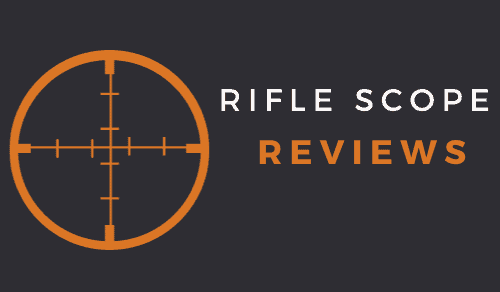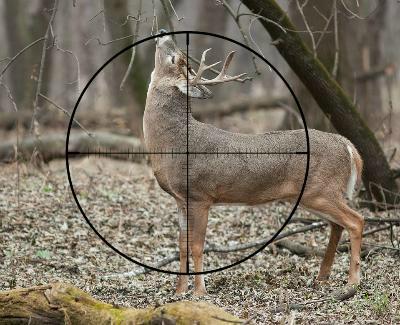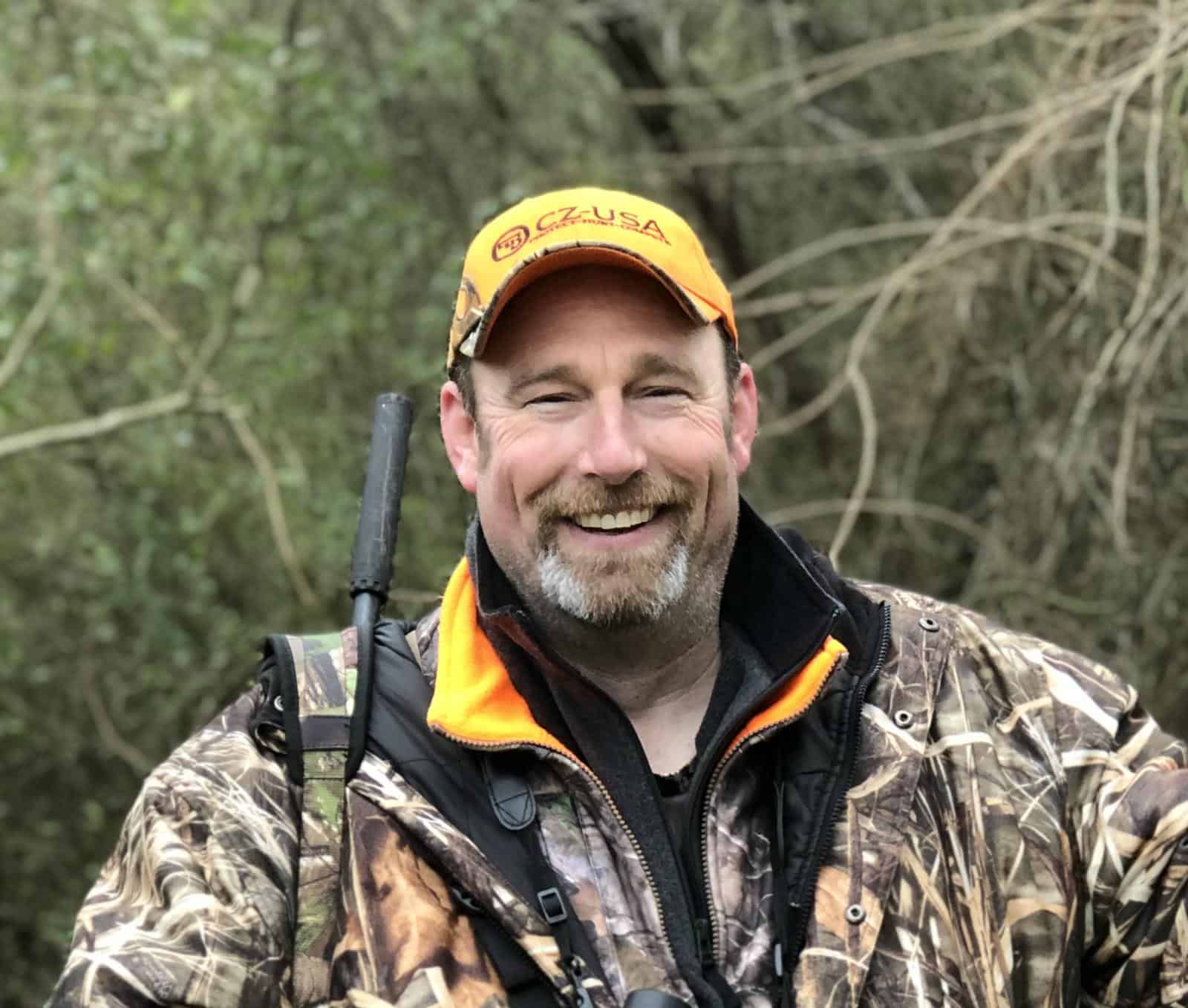As an Amazon Associate I earn from qualifying purchases. Amazon and the Amazon logo are trademarks of Amazon.com, Inc, or its affiliates.
With an estimated 30 million deer licenses and tags issued each year, it’s a safe bet to say that deer hunting is the most popular type of hunting in the U.S. So much so, that most states offer deer seasons with specific methods of taking such as a bow season, muzzleloader season, and then traditional gun season.
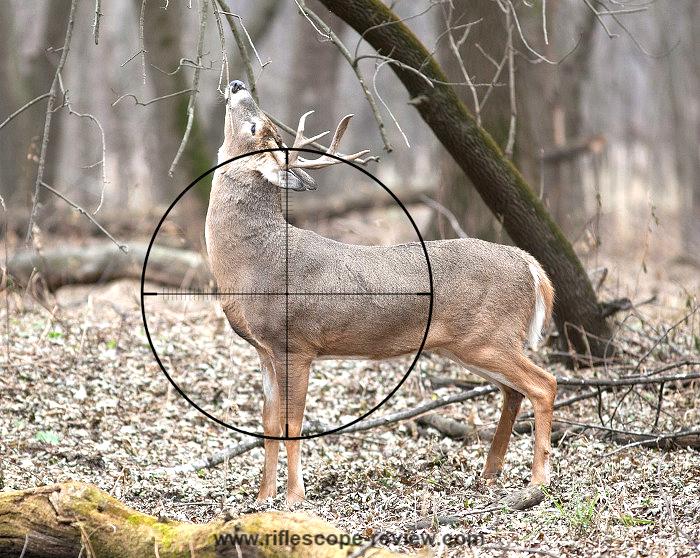
Although all three (3) of the hunting methods are popular, the gun season is the most popular of the three. The gun season allows the use of rifles and shotguns (depending on where you hunt), and most hunters use a rifle scope optic on those long gun styles.
Given the popularity of this type of hunting, a common question I am asked at the scope counter is what’s the best scope magnification for deer hunting?
Now, if someone were asking that question when I was a teenager, about the only answer was a 3X9 scope, because during that time period, the 3×9 was about the only scope magnification that was available.
As a matter of fact, when I first started deer hunting as a teenager, I can’t recall ever seeing a scope on a deer rifle that wasn’t either a 3×9 or a fixed 4X power.
Well, times have changed and the number of scope magnifications for deer hunting have grown significantly. Now there are a number of scope options for deer hunting, with some being more popular than others.
But, before I get into the details of those scope configurations, it’s worth going over a few factors that can and should be considered when choosing a scope magnification on a deer rifle.
Shooting Distances
The distances that you typically shoot can play a role in determining the optimum scope magnification. Now there are a number of factors that can play a role in the expected shooting distances, including:
- Geography where you hunt
- Planned method of deer hunting
Hunting Geography
The geography or area being hunted may play a role as it can determine the max range or most common shooting ranges. For example, I mostly hunt in the Southeastern part of the United States where most shots either occur in thicker wooded areas where the distance is less than 100 yards, or on the edge of agriculture fields where the max distance is usually less than 250 yards.
However, if you happen to be in the Midwest and hunt over the larger corn fields, you might be faced with a shot that exceed 350 yards (depending on your rifle set-up, skill level, and shot confidence) In that scenario, the longer distances would be better served with a higher magnification scope instead of something in the 3×9 range.
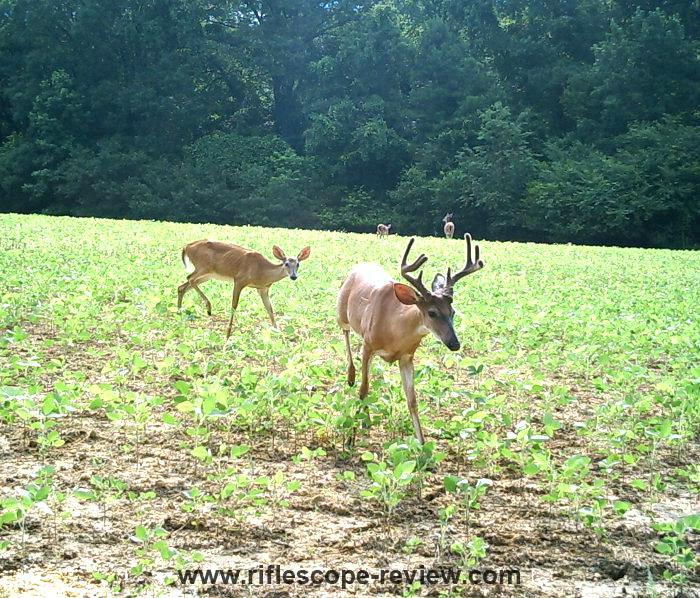
Looking at the image above, let’s be honest: would you rather take a shot at the nice buck who’s really close, or the larger buck that you can barely see in the background?
Type of Hunting
The method that you hunt can also play a role in the typical distances that you shoot. Most deer hunters (at least whitetail deer hunters) hunt from a tree stand, and shots from a tree stand can range from nearly point blank all the way out to whatever distance you feel ethically comfortable (and that’s based on skill level, practice, and equipment) taking a shot.
However, there are other deer hunting approaches that may also play a role in your typical shooting distances. For example, here in eastern NC, doing a deer drive is another popular hunting approach. In that scenario, the distances will usually be less than 100 yards and you’ll be shooting at a target that is most likely moving. For that type of hunting, a lower powered scope with a wide field of view would be a good option.
Here’s a quick story to help illustrate my point about matching the scope to the styles of hunting:
When I was 12 years old, one of my uncles took me on my first ever deer hunt with dogs. He belonged to a hunting club that was doing a kids only deer hunt, and he was nice enough to invite me along. Since dog hunting for deer almost always involves shooting at deer on the move, my father let me borrow his Mossberg 500 20 gauge pump for the hunt. Now, at that time, I had been using his Mossberg to deer hunt so he had mounted an inexpensive 3×9 shotgun scope on it. However, my uncle suggested that he remove the scope so I could shoot with the basic shotgun sight. i liked the scope option so I shrugged off his suggestion and requested my dad leave the scope mounted.
When my dad dropped me off at my uncle’s house the night before the hunt, he again suggested that the scope be removed, but I politely declined saying I liked having the scope mounted.
On the day of the hunt, he and I had taken up a position along the edge of a field as the dogs chased deer our way. I had the scope turned down to the 3x power setting and the shotgun was loaded with 00 buckshot.
Suddenly three 3 (two does and a small buck) burst out of thick woods and were running full speed out of front of me on a right to left route. I shouldered the shotgun, and started trying to track the moving deer in the scope. Unfortunately, they were only about 25 yards in front of me, and, being that close, and moving so fast, I was not able to locate or track them looking through the optic.
I didn’t even get a shot off or even disengage the safety. Right after the deer were out of sight, my uncle asked why I didn’t shoot? I explained that I couldn’t see them through the scope. To which he replied: I know and that’s exactly why I kept suggesting that you take it off the gun.
I learned some valuable lessons that day about listening to people who have been there and done that, and that scopes aren’t always needed for the job. I’m in my early fifties now, and that uncle and I still get a laugh about what he calls “me and my shotgun scope” story.
Field of View
Another feature worth discussing with deer hunting riflescopes is called field of view. A scope field of view is the entire sight picture of a scope as it moves through the power magnification ranges. A scope’s field of view (also called FOV) is measured in feet and references the entire extent of view that the shooter can see at a range of 100 yards.
FOV specifications for scopes are listed at a scope’s lowest and highest power. For example, one of my favorite coyote rifles is a 6.5 Grendel bolt action with a Vortex Strike Eagle 4-24×50 mounted. The FOV specifications from Vortex Optics for that scope are written as follows:
26.2 – 4.3 ft/100 yards
Here’s a screenshot of that information from the Vortex web site:
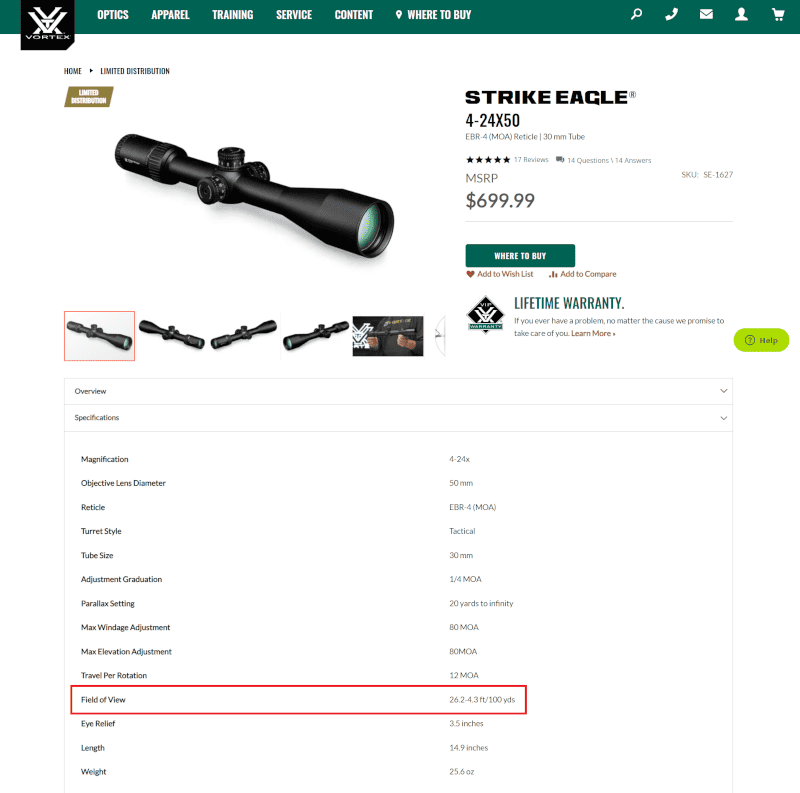
Here’s what that means:
On the 4x power, the field of view is 26.2 feet when viewing a target at 100 yards. On 24x power, the field of view drops down to 4.3 feet of a target at 100 yards.
So, the FOV value drops as the scope magnification increases. In layman’s terms, this means that the total area of a target that a shooter can view through the scope goes down as the scope magnification increases.
For situations where the shooting distance is 50 yards or less, a riflescope on higher magnification will mean that the hunter will see less of the deer in the scope, while they will see more of the deer using a lower magnification power.
Low Light Performance
Deer are most active either early in the morning or in the evening towards sundown. Hunting during those time periods means that the light is either very low and getting brighter or fading. For hunting during those peak times, a scope with optimal low light performance can mean the difference between getting a shot or letting that big buck walk.
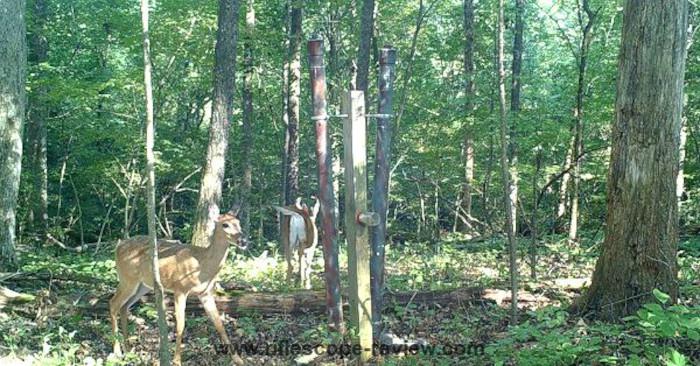
While there are exceptions to every rule, typically, scopes with a higher power magnification require more light at higher power so a mid to lower powered scope is a better option for low light situations. One of my favorite low light deer scopes is 3-10X50 model with a 30mm tube. The 3-10 power range is more than enough for most ethical shots that might be taken during low or lower light.
Lens Quality and Coatings Determine Low Light Capability
A scope’s ability to perform well in low light is determined by the quality of the lens in the scope and the quality of the coatings applied to that lens.
All scope lenses have coatings that are applied by the lens manufacturer or by the optical brand. Those coatings play a major role in the clarity, brightness, and low light capability of an optic. However, those coatings are costly to apply and quality optics require multiple lens coatings to achieve the desired results.
Since the coatings are expensive to apply, higher end optics almost always feature lenses with more coatings compared to an entry level optic. In an indirect way, your budget will play a significant role in a scope’s low light effectiveness. In my experience, there’s a significant difference in a scope’s low light or twilight performance between a $150 scope and a $500 optic. From a low light performance perspective, you tend to get what you pay for.
Illuminated Reticle
Another option to help with low light shooting situations is an illuminated reticle. I’m also a fan of illuminated reticles for low light hunting, but they are not an absolute necessity. The illumination adds weight to the scope, but, for me, it’s a reasonable trade-off to be able to see the reticle for a confident shot placement. However, if you’re a weight conscious hunter, or spend a great deal of time hunting on the move, then the extra weight may not be worth it for you.
Scope Magnification vs Light Transmission
Another point worth discussing for low light scope performance is the relationship between scope magnification power and the amount of light transmitted through the scope.
The concept is fairly simple to understand: as the scope magnification power increases, the image in the scope becomes darker. This phenomenon is especially noticeable in twilight shooting situations.
Illuminated reticles can offer an excellent solution to daybreak or dusk hunting situations when a hunter wants to use a higher magnification power but the image in the scope makes it difficult to see the reticle.
Scope Tube Diameter
Today, rifle scopes are available in a number of different tube diameters, but the 1-inch tube and 30mm tube are the most popular. The 1-inch tube models are more common and cost a bit less, but the 30mm models are rapidly gaining in popularity.
I own scopes in both tube sizes, but the 30mm models are definitely my favorite.
However, if you’re a weight conscious hunter, know that the 30mm tubes typically weigh more than their 1 inch counterparts.
Ideal Scope Magnifications for Hunting Deer
So, let’s look at answering the question of what is the best scope magnification for deer hunting?
Here are my suggestions:
3-9 Power
The 3-9 magnification range is, without a doubt, still the gold standard of magnification range on the market for deer hunting. It’s not my favorite, but I’ve got some older rifles with a 3×9 on them, and they work fine for deer.
The one thing I don’t like about the 3×9 range is the 9X top magnification. While that will work in most situations, it’s not ideal for longer-range shots (at least not for me).
If you are really unsure about the best deer hunting magnification for you, go with a 3×9, as there are plenty of 3×9 options on the market, and they come in a variety of hunting-based reticles.
The one drawback to the 3-9 scope configurations is the fact that most are only available in a 1-inch tube, although there are some 30mm 3x-9x rifle scope options on the market as well.
3-12 Power or 4-12 Power
Personally, I much prefer a 3-12 scope for deer over a 3-9, as the 12x top magnification power can be very handy for longer-range shots. The 4-12 power range is also a favorite of mine as it covers the optimal (at least in my opinion) power ranges for most deer hunting scenarios.
Plus, plenty of 3-12 and 4-12 scope models on the market are available in a 30mm tube. For low-light deer hunting, one favorite glass is a 3-12 scope in 30mm with an illuminated reticle.
4-14 Power
Unless you really happen to be hunting deer in a specific long-range situation, I really think that 4-14 power is the top end of popular magnification ranges for deer hunting scopes. The power is versatile enough to allow for short-range or close-in shots, yet the 14X is more than enough power to offer the ability to really reach out to the most common ethical shooting ranges for deer.
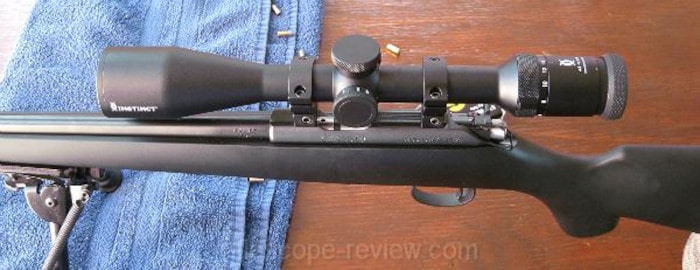
Here are some commonly or frequently asked questions that I hear (and have been asked) about deer hunting rifle scopes:
What is the best rifle scope reticle for deer hunting?
Believe it or not, one of my favorite reticles for deer hunting is the good old-fashioned duplex reticle, as long as the reticle is not thick enough to cover the vitals completely. I’ve never been a fan of a duplex reticle with really thick posts, as they can end up covering up a target or vitals.
200×189 jpg  | 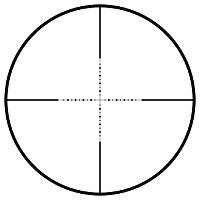 |
Duplex Reticle | Mil-Dot Reticle |
Now, with that being said, I’m also not a fan of a duplex with a reticle so thin that it gets lost in the background or in lower light.
I’m also a fan of mil-dot reticles, as I like the fact that you can use the duplex dot on a mil-dot and then also use the mil-dots for longer-range shots.
With a little bit of experimentation and practice at the range, it’s not hard to get designated range distances established for each mil-dot on the lower post.
I’ve got a shooting buddy who loves mil-dots, and he runs them on almost everything. He’s got one on a high-end .22 bolt action rifle and can routinely hit targets out to 300 yards because he knows the bullet drop for each mil-dot on the lower post of the reticle.
If you’d like to read more about the different reticle options, here’s a link to a post with a more in-depth discussion on rifle scope reticles.
What about an illuminated reticle?
Like most things in life, illuminated reticles offer pros and cons, and I’ll get more into that below. Personally, I like having an illuminated reticle as it’s a huge help for low light shooting.
The downside to illuminated reticles includes the following:
- The illumination feature adds weight to the scope via the necessary electronics and power source. Now, it may only be a few extra ounces, but it’s still more weight. If you are really weight conscious, then it’s something to take into consideration.
- Illumination means electronics, which is one more “moving” part of the scope that can fail. If the illumination does have a malfunction, it can be costly to repair, and most scope manufacturers only warranty the illumination for 12 months. After 12 months, you will most likely pay out of pocket to repair it.
Illumination comes at a slightly higher cost compared to a non-illuminated reticle. If you’re scope shopping on a strict budget, then an illuminated reticle may not be for you.
What about a scope with a lower power, like 2X-7X, for deer hunting?
There’s absolutely nothing wrong with a rifle scope with a lower power or even a fixed lower power (like a fixed 4X) for deer hunting. As long as you are comfortable with the power range and can make ethical shots, then lower power scopes are perfectly fine.
When I was a kid, there was a guy in our neighborhood who bagged several really, really nice bucks, and he shot an older bolt Winchester 30-06 with a fixed 4 power scope on it. He said his longest shot was about 75 yards, so you don’t “need” a high-powered scope to hunt deer.
I’m hunting deer with a shotgun. Do you have any scope suggestions for a deer shotgun?
If you’re deer hunting with a shotgun, then you’re shooting either buckshot or shotgun slugs. Most (although not all) shots taken with a shotgun are going to be relatively short-range shots, so a 3X-9X or lower powered scope works just fine.
The important part of choosing a scope for a shotgun is making sure you pick one with extra long eye relief. You want to make absolutely sure that the scope has enough eye relief so it doesn’t strike your face from the shotgun recoil when a shot is fired. I’ve seen that happen, and it’s not pretty.
My favorite shotgun scopes for deer are these:
What about an FFP scope for deer hunting?
If you prefer FFP scopes over an SFP scope, then there’s really no reason you can use an FFP scope for deer hunting.
As the majority of shots taken on deer are under 150 yards, the thing to keep in mind with an FFP scope is the size of the reticle on lower power. The reticle on an FFP scope is fairly small on the lower power ranges, and then it gets larger as the scope magnification is adjusted upwards.
If you don’t mind the smaller reticle, or if the smaller reticle is an issue, and you don’t mind shooting a deer on a higher magnification, then an FFP scope for deer might be a good option.
At the end of the day, the best scope magnification for deer hunting is the scope configuration that best suits your needs and the one you feel most comfortable using.
I’ve been working in the firearms and sporting optics industry for over 20 years, with a personal and professional interest in all things related to rifle scopes, Through a combination of work experience, formal training, and personal experiences, I have extensive experience mounting, testing, and evaluating different rifle scope models across most major optical brands.
